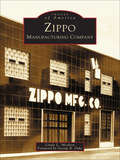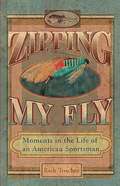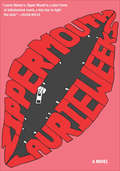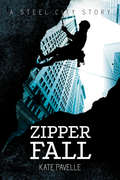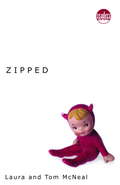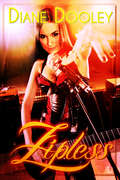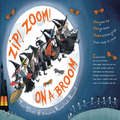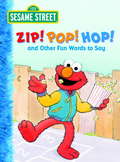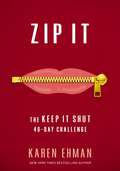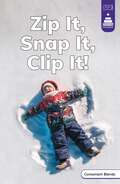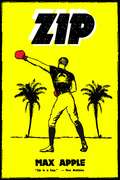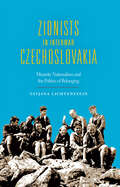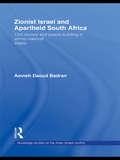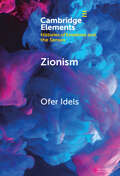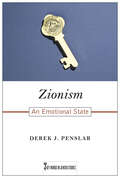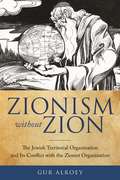- Table View
- List View
Zippo Manufacturing Company (Images of America)
by Linda L. MeabonA photographic history of the family-owned Pennsylvania company that became a household name and a global success story. The Zippo Manufacturing Company was founded in 1932 in Bradford, Pennsylvania, by George G. Blaisdell, who designed the first Zippo lighter in 1933; since then, Zippo has produced nearly four hundred million lighters. The product line eventually expanded to include tape measures and pocket knives. Zippo entered the specialty advertising market in 1935, when the Kendall Refinery ordered five hundred lighters that displayed its name—and since then, the Zippo lighter has become a commemorative showcase for corporate logos, special events, and famous places throughout the United States and around the world.Zippo has been owned and operated by the Blaisdell family for more than seventy years. Zippo Manufacturing Company contains photographs of the Blaisdells, the Zippo Riders, the Zippo ski slope, the Zippo car, special-edition lighters, and scenes from the town of Bradford. Zippo archives and private collections have yielded rare photographs of Zippo employees at work, company and collector events, and other highlights in the company's history—making for a lively journey though this unique piece of American culture.
Zipping My Fly
by Rich ToschesImagine A River Runs Through It seen through the eyes of Dave Barry and you'll get an idea of Rich Tosches' sharp-eyed reflections on the art, hobby, and obsession of fly fishing. Armed with a rod, a pen, and an eccentric sense of humor, Pulitzer Prize-nominated sportswriter Rich Tosches headed for the Grand Teton Mountains, site of the World Fly Fishing Championship, and cast a keen eye on his fellow trollers from all over the globe. This encounter-and many others during a lifetime dedicated to the pursuit of fly fishing -are captured in a side-splitting collection of observations on every angle-and angler-of one of America's favorite pastimes. .
Zipping My Fly
by Rich ToschesImagine A River Runs Through It seen through the eyes of Dave Barry and you'll get an idea of Rich Tosches' sharp-eyed reflections on the art, hobby, and obsession of fly fishing. Armed with a rod, a pen, and an eccentric sense of humor, Pulitzer Prize-nominated sportswriter Rich Tosches headed for the Grand Teton Mountains, site of the World Fly Fishing Championship, and cast a keen eye on his fellow trollers from all over the globe. This encounter-and many others during a lifetime dedicated to the pursuit of fly fishing -are captured in a side-splitting collection of observations on every angle-and angler-of one of America's favorite pastimes.
Zipper Mouth: A Novel
by Laurie WeeksThis novel of a young lesbian addict in &’90s NYC &“recalls Naked Lunch&” with &“dreamy, impressionistic, and rapturous&” prose—&“an ecstatic love story&” (Publishers Weekly). Written in the brash, fervent voice of the young and addicted, this debut novel from underground superstar Laurie Weeks &“is a short tome of infinitesimal reach, a tiny star to light the land&” (Eileen Myles). Strung out on dope and unrequited love for her straight best friend, Jane, the novel&’s unnamed narrator zig-zags between glimpses of her childhood and early teens to the raw, super-caffeinated world of her present on the streets of New York. Chosen by Dave Eggers as Best American Nonrequired Reading and a winner of the 2012 Lambda Literary Awards, this novel encapsulates the soaring highs and gritty lows of the junkie and the reckless intensity of love. &“The book&’s pulse is evident on every page.&” (Lambda Literary) &“Zipper Mouth is a brilliant rabbit hole of pitch-black hilarity, undead obsession, the horror of the everyday, and drug, drugs, drugs.&” —Michelle Tea, co-founder of SisterSpit
Zipper Fall
by Kate PavelleA Steel City StoryWyatt Gaudens, an advertising executive and adrenaline junkie, has fine-tuned the art of breaking and entering into apartments, misusing his considerable rock climbing skills. Once inside, he steals a pretty, shiny thing or two. When his friend Reyna complains that her jerk of a boss makes her workplace a living hell, he breaks into her boss's home to get even. More than any other pretty thing, what really catches his eye the most is her boss, Jack. Working hard to overcome his own lingering problems, investment specialist Jack Azzuri focuses on his second chance at making his business grow. But grief for his sister, Celia, recently killed in a suspicious climbing accident, sabotages his attempt to start over. When he meets Wyatt, he's strongly attracted even though Wyatt is the last person he should associate with. With Jack's explosive temper and Wyatt's adrenaline addiction, the path to a stable relationship will be a tough climb. They might succeed if they can sort out what really matters, as well as learn to take the good with the bad. Wyatt hopes to speed their progress by solving the mystery that's weighing Jack down: how did Celia really die?
Zipped
by Laura Mcneal Tom McnealWHEN 15-YEAR-OLD MICK Nichols opens the wrong e-mail, he learns a terrible secret: His stepmother is having an affair with a man named Alexander Selkirk. Mick is stunned. Should he tell his father, confront his stepmother, or keep it all to himself? And who, exactly, is Alexander Selkirk? Mick becomes obsessed with the infidelity, in spite of some serious distractions. Distractions like Lisa Doyle, the religious field-hockey player with the coppery red hair. Like the surprising (but appreciated) affections of Myra Vidal, a famously gorgeous college freshman with a secret of her own. And at the moment Mick discovers Selkirk's true identity, he realizes his problems are all zipped up together--and that he may have to go to drastic lengths to untangle them."The McNeals spin a wonderfully rich story."--Kirkus Reviews"A well-honed novel. . . . Readers will be sucked in."--Publishers WeeklyFrom the Hardcover edition.
Zipline: The World's Largest Drone Delivery Network
by Tarun Khanna George GonzalezZipline established the world's largest logistics network in Rwanda and Ghana by delivering medical supplies to hospitals via automated drones. The company is now looking to expand in the U.S. and partnered with Walmart to expand into home delivery. Zipline must navigate the U.S. regulatory space while prioritizing its growth opportunities domestically and abroad.
Zipless
by Diane DooleyRocking, rolling and romancing in New York City -- Scottish style! Unable to perform due to paralyzing anxiety, singer-songwriter Lou Marzaroli has been managing her brother's band for years, driving them out of Scotland and into the big time. But days before their American network debut, the band is imploding and Lou is relieving her stress in a no-strings-attached sexual encounter with an aging scenester she's nicknamed Zippy. The Zipman is sometimes remembered as Crash Burns, formerly of seminal L.A. glampunk band, Snakebite. It's been years since he'd trashed the eyeliner and hairspray, and he hasn't written a song since. Now he's penning lyrics about the mysterious woman he last saw sprinting barefoot in a miniskirt down West Twenty Third. She's the muse he's been longing for, and he's determined to be more than her one night stand. When the head honchos learn Lou wrote the band's material, they agree to give her the TV spot, sending her to be coached by their performance guru, Crash Burns. Now Lou must put herself in Zippy's hands as he coaxes a life-changing performance from her. And the man who used to perform in nothing but a leather thong must find ways to get her confident on stage— and content in only one bed."Dooley does spend a lot of time. . .on character development, so the reader becomes involved in Lou's dilemmas and in the romance." –Library Journal 20,390 Words
Zipcar: Refining the Business Model
by Michael J. Roberts Julia D. Stevens Myra M. HartZipcar is a start-up organized around the idea of "sharing" car usage via a membership organization. This case describes several iterations of the Zipcar business model and financial plan. These iterations include a very early version and a version developed just prior to the launch of the business, as well as data from the first few months of operations. Students are called on to analyze the underlying economics and business model for the venture and to discover how these assumptions are holding up as the business is actually rolled out.
Zipcar: Refining the Business Model
by Michael J. Roberts Julia D. Stevens Myra M. HartZipcar is a start-up organized around the idea of "sharing" car usage via a membership organization. This case describes several iterations of the Zipcar business model and financial plan. These iterations include a very early version and a version developed just prior to the launch of the business, as well as data from the first few months of operations. Students are called on to analyze the underlying economics and business model for the venture and to discover how these assumptions are holding up as the business is actually rolled out.
Zipcar: Influencing Customer Behavior
by Frances X. FreiAt Zipcar, customers share the use of cars and, as a result, rely on each other for their service experience. Customers are required to keep the car clean and the gas tank full and to return the car on time. Told from the perspective of two customers: Sal Fishman, who has a car and is running late at an interview, and Anita Karr, who has just arrived at her reserved car's empty parking spot.
Zip! Zoom! On a Broom
by Rosalinde Bonnet Teri SloatOne goes zip,two go zoom.Three witches glide from room to room.So begins this witchy counting story. Counting up from 1 to 10 and back down again, ten witches jump on a broom--and then fall off one by one! Written in pitch-perfect rhyme, and full of fun read-aloud energy that will have kids memorizing lines and clamoring to read the book again and again, this book hits the mash-up sweet spot between an important concept and Halloween fun!
Zip! Pop! Hop! and Other Fun Words to Say (Big Bird's Favorites Board Books)
by Michaela Muntean David PrebennaElmo and his friends have lots of fun saying oodles of words with interesting sounds--and which sometimes feel a little funny in the mouth--such as pop, zip, hopscotch, growl, snip, gurgle, squiggly, ticktock, and lots more. There are giggles galore for babies and toddlers on every single page!From the Board edition.
Zip It: The Keep It Shut 40-Day Challenge
by Karen EhmanZip It empowers readers to put into action the advice and commands of Scripture concerning the tongue. The New York Times bestselling book Keep It Shut covered many topics, including anger, truth-telling, people-pleasing, our digital tongues online, and gossip. Because there are more than 3,500 verses in the Bible that relate to our words and our silence, Keep It Shut only scratched the surface of these issues. Karen Ehman now takes a deeper look and offers practical how-to’s that will inspire you use your words to build, to bless, to encourage, and to praise.Each of the forty interactive entries includes a Scripture verse focus for the day, a story or teaching point, and reflection questions with space for readers to write their answers and thoughts. Each entry ends with both a challenge that will help you carry out the directive in the verse and a prayer prompt. Rather than a traditional devotional,the entries in Zip It build upon each other, equipping you with new habits in how to, or not to, use words.
Zip It, Snap It, Clip It!
by Marley RichmondBefore children go outside in cold weather, they may zip and snap their coats, clip on their gloves, and don their hats. Beginning readers hone their phonics skills while learning about winter clothing and how it keeps us warm. As readers practice decoding words with consonant blends, they gain nonfiction knowledge. Every Stairway Decodables book combines multiple aspects of the Science of Reading to support small group instruction, independent reading, and reading practice at home.
Zip
by Ellie Rollins"Pure whimsical delight. Magic does blow throughout the world, and Zip proves it!" -Lauren Myracle, New York Times bestselling author of ttyl one girl + one scooter = journey of a lifetime When Lyssa’s mother died, so did the magic-that special something that always made the sunflowers grow taller and the strawberry jelly taste sweeter. So when Lyssa receives the alarming news that her childhood home in Texas is about to be bulldozed, she sets off on a two-wheeled cross-country journey to save her family home-and with it, the last remaining sparkle of her earlier life. On her odyssey, Lyssa meets some decidedly unusual people-from rowdy cowgirls to a chorus line of singing mermaids-and discovers adventure at every highway turn. But it’s the magic that she uncovers, little by little, along the way that will ultimately put a new zip in her step! .
Zip
by Max AppleSo what's a nice Jewish boy like Ira Goldstein doing managing a flashy Puerto Rican boxer named Jésus? What is his mother doing in the arms of Solomon, the scrap-metal king of Detroit? And what, for toppers, is J. Edgar Hoover doing in a chair suspended over a boxing ring in Havana, Cuba? Charge it all to zip--that elusive form of human energy that makes hearts leap, cash flow, ideologies tremble, the world go round. Ira could sure use some zip, so he tries to find it.
Zionists in Interwar Czechoslovakia: Minority Nationalism and the Politics of Belonging (The Modern Jewish Experience)
by Tatjana LichtensteinThis book presents an unconventional history of minority nationalism in interwar Eastern Europe. Focusing on an influential group of grassroots activists, Tatjana Lichtenstein uncovers Zionist projects intended to sustain the flourishing Jewish national life in Czechoslovakia. The book shows that Zionism was not an exit strategy for Jews, but as a ticket of admission to the societies they already called home. It explores how and why Zionists envisioned minority nationalism as a way to construct Jews' belonging and civic equality in Czechoslovakia. By giving voice to the diversity of aspirations within interwar Zionism, the book offers a fresh view of minority nationalism and state building in Eastern Europe.
Zionist Israel and Apartheid South Africa: Civil society and peace building in ethnic-national states (Routledge Studies on the Arab-Israeli Conflict)
by Amneh BadranThis book is a comparison of two ethnic-national "apartheid" states – South Africa and Israel – which have been in conflict, and how internal dissent has developed. In particular it examines the evolution of effective white protest in South Africa and explores the reasons why comparably powerful movements have not emerged in Israel. The book reveals patterns of behaviour shared by groups in both cases. It argues that although the role played by protest groups in peace-building may be limited, a tipping point, or ‘magic point’, can become as significant as other major factors. It highlights the role played by intermediate variables that affect the pathways of protest groups: such as changes in the international system; the visions and strategies of resistance movements and their degree of success; the economic relationship between the dominant and dominated side; and the legitimacy of the ideology in power (apartheid or Zionism). Although the politics and roles of protest groups in both cases share some similarities, differences remain. Whilst white protest groups moved towards an inclusive peace agenda that adopts the ANC vision of a united non-racial democratic South Africa, the Jewish Israeli protest groups are still, by majority, entrenched in their support for an exclusive Jewish state. And as such, they support separation between the two peoples and a limited division of mandatory Palestine / ‘Eretz Israel’. This timely book sheds light on a controversial and explosive political issue: Israel being compared to apartheid South Africa.
Zionism’s Redemptions: Images of the Past and Visions of the Future in Jewish Nationalism
by Arieh SaposnikIn this volume, Arieh Saposnik examines the complicated relations between nationalism and religious (and non-religious) redemptive traditions through the case study of Zionism. He provides a new framework for understanding the central ideas of this movement and its relationship to traditional Jewish ideas, Christian thought, and modern secular messianisms. Providing a longue-durée and broad view of the central themes and motivations in the making of Zionism, Saposnik connects its intellectual history with the concrete development of the Zionist project in Israel in its cultural, social, and political history. Saposnik demonstrates how Zionism offers lessons for a politics in which human perfectibility continues to serve as a guiding light and as a counter-narrative to the contemporary politics of self-interest, self-promotion and 'post-truth.' This is a study that bears implications for our understanding of modernity, of space and place, history and historical trajectories, and the place of Jews and Judaism in the modern world.
Zionism: Emotions, Language and Experience (Elements in Histories of Emotions and the Senses)
by Ofer IdelsIs the history of emotions a methodology or a subject? What is the relationship between emotions and culture? What role does the body play in the human experience? Addressing these questions and more, this element emphasizes the often-overlooked role of emotional and sensory experiences when examining the Zionist experience in the early twentieth century. Focusing on the visceral and embodied historical aspects of the linguistic modernization of Hebrew, it argues that recent cultural studies on Jewish daily life in Palestine have reached an impasse, which the history of emotions could help us overcome. Interpreting Zionist texts not solely as symbolic myths but as a historical, lived experience, this element advocates for the significance of the history of emotions and experience as an innovative methodology with profound ethical implications for our polarized era.
Zionism: An Emotional State (Key Words in Jewish Studies)
by Derek J. PenslarEmotion lies at the heart of all national movements, and Zionism is no exception. For those who identify as Zionist, the word connotes liberation and redemption, uniqueness and vulnerability. Yet for many, Zionism is a source of distaste if not disgust, and those who reject it are no less passionate than those who embrace it. The power of such emotions helps explain why a word originally associated with territorial aspiration has survived so many years after the establishment of the Israeli state. Zionism: An Emotional State expertly demonstrates how the energy propelling the Zionist project originates from bundles of feeling whose elements have varied in volume, intensity, and durability across space and time. Beginning with an original typology of Zionism and a new take on its relationship to colonialism, Penslar then examines the emotions that have shaped Zionist sensibilities and practices over the course of the movement’s history. The resulting portrait of Zionism reconfigures how we understand Jewish identity amidst continuing debates on the role of nationalism in the modern world.
Zionism, Palestinian Nationalism and the Law: 1939-1948 (UCLA Center for Middle East Development (CMED))
by Steven E. ZippersteinDuring the last decade of the British Mandate for Palestine (1939–1948), Arabs and Jews used the law as a resource to gain leverage against each other and to influence international opinion. The parties invoked "transformational legal framing" to portray the essentially political-religious conflict as a legal dispute involving claims of justice, injustice, and victimisation, and giving rise to legal/equitable remedies. Employing this form of narrative and framing in multiple "trials" during the first 15 years of the Mandate, the parties continued the practice during the last and most crucial decade of the Mandate. The term "trial" provides an appropriate typology for understanding the adversarial proceedings during those years in which judges, lawyers, witnesses, cross-examination, and legal argumentation played a key role in the conflict. The four trials between 1939 and 1947 produced three different outcomes: the one-state solution in favour of the Palestinian Arabs, the no-state solution, and the two-state solution embodied in the United Nations November 1947 partition resolution, culminating in Israel's independence in May 1948. This study analyses the role of the law during the last decade of the British Mandate for Palestine, making an essential contribution to the literature on lawfare, framing and narrative, and the Arab-Israeli Conflict.
Zionism without Zion: The Jewish Territorial Organization and Its Conflict with the Zionist Organization
by Gur AlroeyWhile the ideologies of Territorialism and Zionism originated at the same time, the Territorialists foresaw a dire fate for Eastern European Jews, arguing that they could not wait for the Zionist Organization to establish a Jewish state in Palestine. This pessimistic worldview led Territorialists to favor a solution for the Jewish state "here and now"--and not only in the Land of Israel. In Zionism without Zion: The Jewish Territorial Organization and Its Conflict with the Zionist Organization, author Gur Alroey examines this group's unique perspective, its struggle with the Zionist movement, its Zionist rivals' response, and its diplomatic efforts to obtain a territory for the Jewish people in the first decades of the twentieth century. Alroey begins by examining the British government's Uganda Plan and the ensuing crisis it caused in the Zionist movement and Jewish society. He details the founding of the Jewish Territorial Organization (ITO) in 1903 and explains the varied reactions that the Territorialist ideology received from Zionists and settlers in Palestine. Alroey also details the diplomatic efforts of Territorialists during their desperate search for a suitable territory, which ultimately never bore fruit. Finally, he attempts to understand the reasons for the ITO's dissolution after the Balfour Declaration, explores the revival of Territorialism with the New Territorialists in the 1930s and 1940s, and describes the similarities and differences between the movement then and its earlier version. Zionism without Zion sheds new light on the solutions Territorialism proposed to alleviate the hardship of Eastern European Jews at the start of the twentieth century and offers fresh insights into the challenges faced by Zionism in the same era. The thorough discussion of this under-studied ideology will be of considerable interested to scholars of Eastern European history, Jewish history, and Israel studies.
